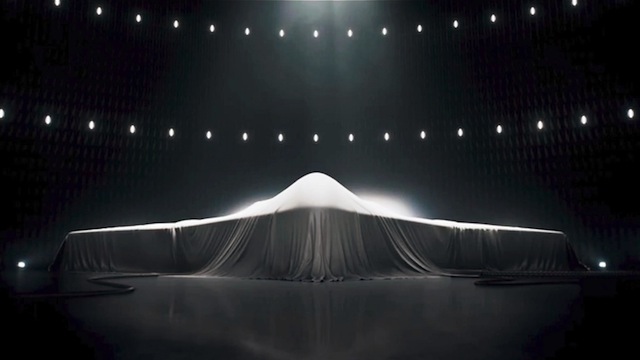The US Air Force has chosen Northrop Grumman to build America’s next stealth bomber in a landmark decision announced by service secretary Deborah Lee James at the Pentagon on 27 October.
Northrop’s victory in the $80 billion Long Range Strike Bomber (LRS-B) competition has been described as “stunning upset” against the cashed-up team of Boeing and Lockheed Martin, and secures the B-2 creator’s place as a top-tier military aircraft manufacturer for decades to come.
The development contract includes options for the first 21 aircraft of what could become an at least 100-aircraft production run. Pentagon estimators place the cost of development at $23.5 billion in fiscal year 2016 dollars, and the aircraft itself valued at $564 million per copy.
Those costs hold up favourably against the $1.5 billion cost of each Northrop’s B-2 when adjusted for inflation, but the new aircraft will be $145 million higher than the supersonic Rockwell B-1B bomber, which cost $410 million each over a production run of 100 aircraft.
“Northrop’s victory in the bomber competition is a stunning upset, that demonstrates an underdog can still beat the best-endowed team in the industry,” says Loren Thompson of the Lexington Institute. “This completely changes the business outlook for Northrop, and makes it look far more resilient company with a bright future.”
The award to Northrop changes the face of the aerospace industrial base, and potentially averts the breakup of the company. Had the company lost the LRS-B contract, elements could have been sold off to the highest bidder, says Teal Group vice-president and consultant Richard Aboulafia.
Instead, Lockheed’s fortunes are secure with the F-35, Boeing’s KC-46 programme is gaining momentum, and Northrop has secured LRS-B.
The win is a major morale boost Northrop’s operations in Palmdale, California and Melbourne, Florida, but a devastating blow to Boeing’s combat aircraft sites in St Louis, Missouri, that were inherited from McDonnell Douglas.
Facing the end of F-15, F/A-18E/F Super Hornet and EA-18G Growler by the end of the decade, Boeing will struggle to maintain its combat aircraft manufacturing capacity without winning more Super Hornet orders or the air force’s near-term T-X contract for the development and production of a next-generation fighter trainer.
USAF officials claim industrial base concerns were not a factor in the competition, but Northrop’s selection does potentially avert further consolidation of the industrial base, which has become a significant concern for the Pentagon following Lockheed’s acquisition of Sikorsky.
“The source selection criteria that was finalised when the [Request for Proposals] criteria went out in 2014 did not have industrial base in them, and those remain unchanged through to today,” says USAF acquisition chief William LaPlante. The Boeing/Lockheed team could still protest the contract award, and the air force says the debriefing process could start as early as Friday.
The loosing team expressed disappointed in a statement issued after the award, saying it is already considering its next move.
“We are interested in knowing how the competition was scored in terms of price and risk, as we believe that the combination of Boeing and Lockheed Martin offers unparalleled experience, capability and resources for this critically important recapitalisation program,” Boeing and Lockheed say in a joint statement.
While the announcement settles the question of the LRS-B manufacturer, most details about the winning design including performance and suppliers remain a heavily-classified mystery.
The engine manufacturer has not been disclosed, but engine maker Pratt & Whitney offered their congratulations to the winning bidder.
“P&W congratulates Northrop Grumman for their selection on this very important program,” the company says. “P&W declines to comment on any other questions regarding the Long-Range Strike Bomber program.”
US Air Force has declined to name any suppliers or provide any significant new information other than the prime contractor, and even the aircraft’s designation is still under consideration, it says.
And despite previously saying it would provide the quantity of engineering and manufacturing development (EMD) aircraft included in the development contract, the air force has reneged and will instead keep that information secret. Even the development timeline for the LRS-B programme remains shrouded by vague terms of budget documents, with air force officials saying the new bomber force is expected to be fielded by the mid-2020s.
The LRS-B fleet is needed to replace the Boeing B-52H and Rockwell B-1B fleets that lack low observability to radar. The Air Force Rapid Capabilities Office directed the three-year-long prototyping, risk-reduction and source selection process with each side's design being brought up to the preliminary design review stage. A contract award was originally expected last spring, but was delayed for months with no explanation.
With the manufacture decided, Mark Gunzinger of Center for Strategic and Budgetary Assessments says the bomber should be delivered as quickly as possible to fill America’s “long-range-strike gap”.
He says the current B-2 fleet can generate 12 to 13 sorties per day at best, and an “all-aspect stealth” aircraft is critically needed to boost those numbers and keep ahead of Russia and China.
“To the extent we delay boosting that capacity, we’re assuming risk. A lot of risk,” he says. “If we lose our ability to hit any target in the world when needed and directed by the president, we lose something as a superpower. It’s not surprising Russia and China aspire to have that kind of capability.”

Source: FlightGlobal.com
















